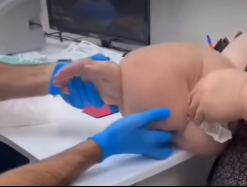
When Your Hand Starts to Look Like an Elephant’s Leg… See More
Imagine waking up one morning and noticing something strange about your hand. It feels heavier than usual, slightly swollen—maybe you think you slept on it wrong or it’s a temporary reaction to something minor. Weeks pass. The swelling doesn’t go down. In fact, it gets worse. Your skin begins to thicken and tighten. The shape of your hand slowly changes, becoming rough, enlarged, and unfamiliar. Eventually, it no longer even looks like a hand—it resembles the thick, rough, and massively swollen leg of an elephant.
This is not a scene from a horror movie. This is the reality of a medical condition called elephantiasis, and while it more commonly affects the legs and genital areas, it can also profoundly alter the appearance and function of human hands.
Elephantiasis, known scientifically as lymphatic filariasis, is one of the most visually striking and physically debilitating neglected tropical diseases in the world. It’s caused by tiny, thread-like parasitic worms—Wuchereria bancrofti, Brugia malayi, and Brugia timori—transmitted through the bites of infected mosquitoes. When these microscopic worms enter the body, they travel to the lymphatic system, the network of tissues and organs that help clear toxins and waste. There, they grow, multiply, and slowly cause blockages that prevent lymph fluid from flowing properly.
Over time—often years—this fluid builds up, leading to extreme swelling. The skin becomes thick, hard, and folded, similar to elephant skin. This is where the name comes from. But elephantiasis isn’t just about appearance. It’s painful, isolating, and often leads to severe physical limitations and social stigma.
When it affects the hand, the consequences are especially devastating. Our hands are fundamental to how we interact with the world—how we eat, work, write, create, and connect with others through touch. People living with hand elephantiasis often struggle with basic tasks like holding a spoon, turning a key, or buttoning a shirt. Many can no longer work, and some eventually withdraw from society due to shame or physical discomfort.
Symptoms develop gradually:
- Persistent swelling that doesn’t improve with elevation or rest
- Skin that becomes thick, rough, and hyperpigmented
- Pain, aching, or recurring infections in the affected hand
- Loss of mobility and strength
Although there is no complete cure once significant tissue damage has occurred, early diagnosis and treatment can dramatically slow the disease’s progress. Medications like ivermectin or diethylcarbamazine (DEC) can kill the young worms circulating in the blood. Compression garments, physical therapy, and meticulous skin care can also help manage swelling and reduce the risk of infection.
The tragedy of elephantiasis is that it is largely preventable. Improved mosquito control, mass drug administration in high-risk areas, and greater public awareness could significantly reduce its impact. Yet it continues to affect millions of people in tropical and subtropical regions—often in communities with limited access to healthcare.
This condition is more than a medical curiosity. It’s a reminder of how vulnerable the human body is, and how profoundly diseases can affect not only how we look, but how we live—and how we see ourselves.
If you ever notice unusual, persistent swelling in any part of your body—especially if you live in or have traveled to a region where lymphatic filariasis is common—see a doctor. Early intervention can change the course of this disease. And spreading knowledge can help end the stigma that surrounds it.